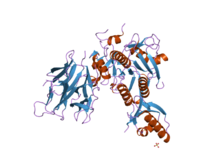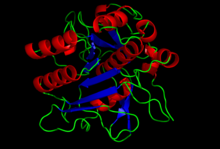Subtilisin: Difference between revisions
m Dating maintenance tags: {{Cleanup section}} |
Artoria2e5 (talk | contribs) →Nomenclature: There, now we are describing the clade. |
||
| Line 41: | Line 41: | ||
== Nomenclature == |
== Nomenclature == |
||
"Subtilisin" does not refer to a single protein, but to an entire [[clade]] under [[subtilases]] containing the classical subtilisins. The clade can be further divided into four grousp: true subtilisins (containg the classical members), high-alkaline subtilisins, intracellular subtilisins, and phylogenetically intermediate subtilisins (PIS).<ref name="Falkenberg22">{{cite journal |last1=Falkenberg |first1=Fabian |last2=Rahba |first2=Jade |last3=Fischer |first3=David |last4=Bott |first4=Michael |last5=Bongaerts |first5=Johannes |last6=Siegert |first6=Petra |title=Biochemical characterization of a novel oxidatively stable, halotolerant, and high‐alkaline subtilisin from Alkalihalobacillus okhensis Kh10‐101 T |journal=FEBS Open Bio |date=October 2022 |volume=12 |issue=10 |pages=1729–1746 |doi=10.1002/2211-5463.13457}}</ref><ref name="p36225363">{{cite journal |last1=Falkenberg |first1=F |last2=Bott |first2=M |last3=Bongaerts |first3=J |last4=Siegert |first4=P |title=Phylogenetic survey of the subtilase family and a data-mining-based search for new subtilisins from Bacillaceae. |journal=Frontiers in microbiology |date=2022 |volume=13 |pages=1017978 |doi=10.3389/fmicb.2022.1017978 |pmid=36225363 |pmc=9549277}}</ref> Notable subtilisin include: |
|||
{{cleanup section|reason=these are not all the same Subtilisin. For example, Alcalase is from B. lichenformes, while Savinase is from… Lederbergia lenta?|date=January 2024}} |
|||
Subtilisin is also commercially known as ''Alcalase®'', ''Endocut-02L'', ''ALK-enzyme'', ''bacillopeptidase'', ''Bacillus subtilis alkaline proteinase bioprase'', ''bioprase AL'', ''colistinase'', ''genenase I'', ''Esperase®'', ''maxatase'', ''protease XXVII'', ''thermoase'', ''superase'', ''subtilisin DY'', ''subtilopeptidase'', ''SP 266'', ''Savinase®'', Savinase''® Evity,'' ''kazusase'', ''protease VIII'', ''protin A 3L'', ''orientase 10B'', ''protease S, Progress® Uno, Liquanase® Evity®, Progress® Excel .'' It is the type [[serine endopeptidase]] of MEROPS family S8. |
|||
{|class="wikitable sortable" |
|||
! Family !! Organism !! Uniprot !! Names !! Notes |
|||
|- |
|||
| True || ''[[Bacillus licheniformis|B. licheniformis]]'' || ? || Subtilisin Carlsberg, ''Alcalase'' (Novozymes), ''Maxatase'' (?)<br>"subtilisin DY" (X-ray mutant)<ref>{{cite journal |last1=Eschenburg |first1=S |last2=Genov |first2=N |last3=Peters |first3=K |last4=Fittkau |first4=S |last5=Stoeva |first5=S |last6=Wilson |first6=KS |last7=Betzel |first7=C |title=Crystal structure of subtilisin DY, a random mutant of subtilisin Carlsberg. |journal=European journal of biochemistry |date=15 October 1998 |volume=257 |issue=2 |pages=309-18 |doi=10.1046/j.1432-1327.1998.2570309.x |pmid=9826175}}</ref> || Type [[serine endopeptidase]] of MEROPS family S8. |
|||
|- |
|||
| ? || ''B. licheniformis'' || ? || ''Endocut-02L'' (Tailorzyme ApS) || |
|||
|- |
|||
| ? || ? || ? || ''bioprase'', ''bioprase AL'' || |
|||
|- |
|||
| ? || ''[[Lederbergia lenta]]'' || || Esperase (Novozymes) || Structure determined, but not found on PDB.<ref name="pmid8796310">{{cite journal |last1=Betzel |first1=C |last2=Klupsch |first2=S |last3=Branner |first3=S |last4=Wilson |first4=KS |title=Crystal structures of the alkaline proteases savinase and esperase from Bacillus lentus. |journal=Advances in experimental medicine and biology |date=1996 |volume=379 |pages=49-61 |doi=10.1007/978-1-4613-0319-0_7 |pmid=8796310}}</ref> |
|||
|- |
|||
| High-alkaline || ''[[Lederbergia lenta]]'' || {{UniProt|P29600}} || Subtilisin Savinase, Savinase (Novozymes) || {{PDB|1SVN}}<ref>{{cite journal |last1=Betzel |first1=C |last2=Klupsch |first2=S |last3=Papendorf |first3=G |last4=Hastrup |first4=S |last5=Branner |first5=S |last6=Wilson |first6=KS |title=Crystal structure of the alkaline proteinase Savinase from Bacillus lentus at 1.4 A resolution. |journal=Journal of molecular biology |date=20 January 1992 |volume=223 |issue=2 |pages=427-45 |doi=10.1016/0022-2836(92)90662-4 |pmid=1738156}}</ref> |
|||
|- |
|||
| True || ''[[Bacillus amyloliquefaciens|B. amyloliquefaciens]]'' || {{UniProt|P00782}} || Subtilisin BPN’ || |
|||
|- |
|||
| ? || ''[[Geobacillus stearothermophilus]]'' || ? || ''Thermoase'' (Amano) || <ref>{{cite web |title=THERMOASE PC10F by Amano Enzyme U.S.A. Co., Ltd. - Food, Beverage & Nutrition |url=https://www.ulprospector.com/en/na/Food/Detail/4153/116967/THERMOASE-PC10F |website=www.ulprospector.com}}</ref> |
|||
|} |
|||
Other non-commercial names include ''ALK-enzyme'', ''bacillopeptidase'', ''Bacillus subtilis alkaline proteinase'', ''colistinase'', ''genenase I'', ''protease XXVII'', ''subtilopeptidase'', ''kazusase'', ''protease VIII'', ''protin A 3L'', ''protease S''. |
|||
Other commercial names with unidentified molecular identities include ''SP 266'', ''orientase 10B'' (HBI Enzymes), ''Progress'' (Novozyme), ''Liquanase'' (Novozyme). |
|||
== Structure == |
== Structure == |
||
Revision as of 07:19, 9 January 2024
| Peptidase S8, subtilisin-related | |||||||||
|---|---|---|---|---|---|---|---|---|---|
 | |||||||||
| Identifiers | |||||||||
| Symbol | Peptidase_S8 | ||||||||
| Pfam | PF00082 | ||||||||
| InterPro | IPR015500 | ||||||||
| PROSITE | PDOC00125 | ||||||||
| CATH | 1cse | ||||||||
| SCOP2 | 1cse / SCOPe / SUPFAM | ||||||||
| CDD | cd07477 | ||||||||
| |||||||||
| Subtilisin BPN' | |||||||
|---|---|---|---|---|---|---|---|
 Crystal structure of subtilisin S8 domain.[1] | |||||||
| Identifiers | |||||||
| Organism | |||||||
| Symbol | apr | ||||||
| CAS number | 9014-01-1 | ||||||
| Entrez | 5712479 | ||||||
| PDB | 1st2 More structures | ||||||
| UniProt | P00782 | ||||||
| Other data | |||||||
| EC number | 3.4.21.62 | ||||||
| |||||||
| GO:0004252 | |||||||
Subtilisin is a protease (a protein-digesting enzyme) initially obtained from Bacillus subtilis.[2][3][4][5][6][7][8]
Subtilisins belong to subtilases, a group of serine proteases that – like all serine proteases – initiate the nucleophilic attack on the peptide (amide) bond through a serine residue at the active site. Subtilisins typically have molecular weights 27kDa. They can be obtained from certain types of soil bacteria, for example, Bacillus amyloliquefaciens from which they are secreted in large amounts.
Nomenclature
"Subtilisin" does not refer to a single protein, but to an entire clade under subtilases containing the classical subtilisins. The clade can be further divided into four grousp: true subtilisins (containg the classical members), high-alkaline subtilisins, intracellular subtilisins, and phylogenetically intermediate subtilisins (PIS).[9][10] Notable subtilisin include:
| Family | Organism | Uniprot | Names | Notes |
|---|---|---|---|---|
| True | B. licheniformis | ? | Subtilisin Carlsberg, Alcalase (Novozymes), Maxatase (?) "subtilisin DY" (X-ray mutant)[11] |
Type serine endopeptidase of MEROPS family S8. |
| ? | B. licheniformis | ? | Endocut-02L (Tailorzyme ApS) | |
| ? | ? | ? | bioprase, bioprase AL | |
| ? | Lederbergia lenta | Esperase (Novozymes) | Structure determined, but not found on PDB.[12] | |
| High-alkaline | Lederbergia lenta | P29600 | Subtilisin Savinase, Savinase (Novozymes) | PDB: 1SVN[13] |
| True | B. amyloliquefaciens | P00782 | Subtilisin BPN’ | |
| ? | Geobacillus stearothermophilus | ? | Thermoase (Amano) | [14] |
Other non-commercial names include ALK-enzyme, bacillopeptidase, Bacillus subtilis alkaline proteinase, colistinase, genenase I, protease XXVII, subtilopeptidase, kazusase, protease VIII, protin A 3L, protease S.
Other commercial names with unidentified molecular identities include SP 266, orientase 10B (HBI Enzymes), Progress (Novozyme), Liquanase (Novozyme).
Structure
The structure of subtilisin has been determined by X-ray crystallography. The mature form is a 275-residue globular protein with several alpha-helices, and a large beta-sheet. The N-terminal contains an I9 propeptide domain (InterPro: IPR010259) that assists the folding of subtilisin. Proteolytic removal of the domain activates the enzyme. It is structurally unrelated to the chymotrypsin-clan of serine proteases, but uses the same type of catalytic triad in the active site. This makes it a classic example of convergent evolution.
Mechanism of catalysis
The active site features a charge-relay network involving Asp-32, His-64, and active site Ser-221 arranged in a catalytic triad. The charge-relay network functions as follows: The carboxylate side-chain of Asp-32 hydrogen-bonds to a nitrogen-bonded proton on His-64's imidazole ring. This is possible because Asp is negatively charged at physiological pH. The other nitrogen on His-64 hydrogen-bonds to the O-H proton of Ser-221. This last interaction results in charge-separation of O-H, with the oxygen atom being more nucleophilic. This allows the oxygen atom of Ser-221 to attack incoming substrates (i.e., peptide bonds), assisted by a neighboring carboxyamide side-chain of Asn-155.
Even though Asp-32, His-64, and Ser-221 are sequentially far apart, they converge in the 3D structure to form the active site.
To summarize the interactions described above, Ser-221 acts as a nucleophile and cleaves peptide bonds with its partially negative oxygen atom. This is possible due to the nature of the charge-relay site of subtilisin.
Applications
Research tool
In molecular biology using B. subtilis as a model organism, the gene encoding subtilisin (aprE) is often the second gene of choice after amyE for integrating reporter constructs into, due to its dispensability.
Commercial
Protein-engineered subtilisins are widely used in commercial products (the native enzyme is easily inactivated by detergents and high temperatures) and is also called a stain cutter, for example, in laundry[15] and dishwashing detergents, cosmetics, food processing,[16] skin care products, contact lens cleaners, and for research in synthetic organic chemistry.
Occupational safety and health
People can be exposed to subtilisin in the workplace by breathing it in, swallowing it, skin contact, and eye contact. The National Institute for Occupational Safety and Health (NIOSH) has set a recommended exposure limit (REL) of 60 ng/m3 over a 60-minute period.[17]
Subtilisin can cause "enzymatic detergent asthma". People who are sensitive to Subtilisin (Alcalase) usually are also allergic to the bacterium Bacillus subtilis. [18]
References
- ^ PDB: 1st2; Bott R, Ultsch M, Kossiakoff A, Graycar T, Katz B, Power S (June 1988). "The three-dimensional structure of Bacillus amyloliquefaciens subtilisin at 1.8 A and an analysis of the structural consequences of peroxide inactivation". The Journal of Biological Chemistry. 263 (16): 7895–906. doi:10.1016/S0021-9258(18)68582-5. PMID 3286644.
- ^ Ottesen M, Svendsen I (1970). "The subtilisins". Methods Enzymol. 19: 199–215. doi:10.1016/0076-6879(70)19014-8.
- ^ Markland FS, Smith EL (1971). "Subtilisins: primary structure, chemical and physical properties". In Boyer PD (ed.). The Enzymes. Vol. 3 (3rd ed.). New York: Academic Press. pp. 561–608.
- ^ Philipp M, Bender ML (1983). "Kinetics of subtilisin and thiolsubtilisin". Molecular and Cellular Biochemistry. 51 (1): 5–32. doi:10.1007/bf00215583. PMID 6343835. S2CID 24136200.
- ^ Nedkov P, Oberthür W, Braunitzer G (April 1985). "Determination of the complete amino-acid sequence of subtilisin DY and its comparison with the primary structures of the subtilisins BPN', Carlsberg and amylosacchariticus". Biological Chemistry Hoppe-Seyler. 366 (4): 421–30. doi:10.1515/bchm3.1985.366.1.421. PMID 3927935.
- ^ Ikemura H, Takagi H, Inouye M (June 1987). "Requirement of pro-sequence for the production of active subtilisin E in Escherichia coli". The Journal of Biological Chemistry. 262 (16): 7859–64. doi:10.1016/S0021-9258(18)47646-6. PMID 3108260.
- ^ Polgár L (1987). "Structure and function of serine proteases". In Brocklehurst K, Neuberger A (eds.). Hydrolytic enzymes. Amsterdam: Elsevier. ISBN 0-444-80886-8.
- ^ Vasantha N, Thompson LD, Rhodes C, Banner C, Nagle J, Filpula D (September 1984). "Genes for alkaline protease and neutral protease from Bacillus amyloliquefaciens contain a large open reading frame between the regions coding for signal sequence and mature protein". Journal of Bacteriology. 159 (3): 811–9. doi:10.1128/JB.159.3.811-819.1984. PMC 215730. PMID 6090391.
- ^ Falkenberg, Fabian; Rahba, Jade; Fischer, David; Bott, Michael; Bongaerts, Johannes; Siegert, Petra (October 2022). "Biochemical characterization of a novel oxidatively stable, halotolerant, and high‐alkaline subtilisin from Alkalihalobacillus okhensis Kh10‐101 T". FEBS Open Bio. 12 (10): 1729–1746. doi:10.1002/2211-5463.13457.
- ^ Falkenberg, F; Bott, M; Bongaerts, J; Siegert, P (2022). "Phylogenetic survey of the subtilase family and a data-mining-based search for new subtilisins from Bacillaceae". Frontiers in microbiology. 13: 1017978. doi:10.3389/fmicb.2022.1017978. PMC 9549277. PMID 36225363.
{{cite journal}}: CS1 maint: unflagged free DOI (link) - ^ Eschenburg, S; Genov, N; Peters, K; Fittkau, S; Stoeva, S; Wilson, KS; Betzel, C (15 October 1998). "Crystal structure of subtilisin DY, a random mutant of subtilisin Carlsberg". European journal of biochemistry. 257 (2): 309–18. doi:10.1046/j.1432-1327.1998.2570309.x. PMID 9826175.
- ^ Betzel, C; Klupsch, S; Branner, S; Wilson, KS (1996). "Crystal structures of the alkaline proteases savinase and esperase from Bacillus lentus". Advances in experimental medicine and biology. 379: 49–61. doi:10.1007/978-1-4613-0319-0_7. PMID 8796310.
- ^ Betzel, C; Klupsch, S; Papendorf, G; Hastrup, S; Branner, S; Wilson, KS (20 January 1992). "Crystal structure of the alkaline proteinase Savinase from Bacillus lentus at 1.4 A resolution". Journal of molecular biology. 223 (2): 427–45. doi:10.1016/0022-2836(92)90662-4. PMID 1738156.
- ^ "THERMOASE PC10F by Amano Enzyme U.S.A. Co., Ltd. - Food, Beverage & Nutrition". www.ulprospector.com.
- ^ "Spar Washing Detergent contents".
- ^ Chaplin M (20 December 2004). "Applications of proteases in the food industry". London South Bank University. Archived from the original on 2010-03-14. Retrieved 3 March 2015.
- ^ "CDC - NIOSH Pocket Guide to Chemical Hazards - Subtilisins". www.cdc.gov. Retrieved 2015-11-21.
- ^ Mosby's Medical, Nursing, & Allied Health Dictionary, 14th edition, page 557
